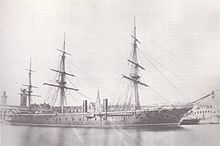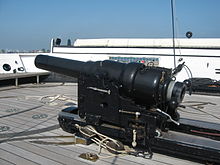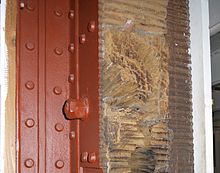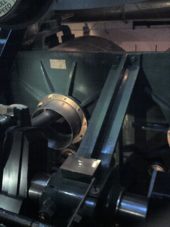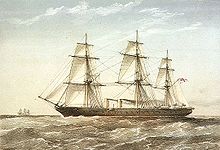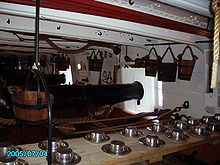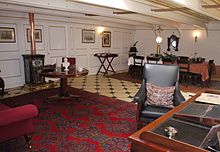- HMS Warrior (1860)
-
For other ships of the same name, see HMS Warrior.
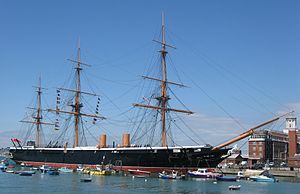
HMS WarriorCareer (UK) 
Name: HMS Warrior Ordered: 11 May 1859 Builder: Thames Ironworks and Shipbuilding Co. Ltd Cost: £377,292 Laid down: 25 May 1859 Launched: 29 December 1860 Commissioned: 1 August 1861 Status: Museum ship General characteristics Class and type: Warrior class armoured frigate Displacement: 9,210 long tons (9,358 t) Length: 418 ft (127 m)[1] Beam: 58.4 ft (17.8 m)[1] Draught: 26 ft (7.9 m)[1] Propulsion: Penn jet-condensing, horizontal trunk, single expansion steam engine Sail plan: Full rigged ship Speed: 13 knots (24.1 km/h) (sail)
14.5 kn (26.9 km/h) (steam)
17.5 kn (32.4 km/h) (combined)Complement: 705 officers and men Armament: 26 muzzle-loading 68-pounder guns
4 RBL 40 pounder Armstrong guns
10 RBL 7 inch Armstrong gunsHMS Warrior was the first iron-hulled, armour-plated warship, built for the Royal Navy in response to the first ironclad warship, the French Gloire, launched a year earlier.
When completed in October 1861, Warrior was by far the largest, fastest, most heavily armed and most heavily armoured warship the world had seen. She was almost twice the size of Gloire and thoroughly outclassed the French ship in speed, armour, and gunnery.
Warrior did not introduce any radical new technology, but for the first time combined steam engines, rifled breech-loading guns, iron construction, iron armour, and the propeller in one ship, and all built to an unprecedented scale.
Her construction started an intense international competition between guns and armour that did not end until air power made battleships obsolete in the Second World War. Warrior became an early example of the trend towards rapid battleship obsolescence and was withdrawn as a fighting unit in May 1883. Listed as part of the National Historic Fleet, Core Collection, she is now a museum ship in Portsmouth, United Kingdom.
Contents
Design and construction
News of the highly secret designs for the Gloire reached the British Admiralty in May 1858. The close co-operation that had existed between France and Britain during the Crimean War had disappeared quickly, and all details of Gloire and her sister ships were treated with great secrecy in France. The new Government under Lord Derby did not begin to take the threat of a new building programme within France seriously until August 1858, when it became apparent that France would soon gain parity with the Royal Navy in terms of steam-powered ships, and utterly outclass the RN in terms of ironclads.
After strong representations by Admiral Sir Baldwin Wake-Walker, the Surveyor of the Navy, and Henry Corry, the Parliamentary under-secretary to the Admiralty, the Board of Admiralty was moved on 22 November 1858 to call for designs for a wooden-hulled, armour-plated warship, whose dimensions were approximately equal to those of Gloire.
It does not appear that Wake-Walker or his chief constructor – Isaac Watts – ever seriously considered wood as a building material.[citation needed] Wooden ships had reached their maximum size, and some of the largest were beginning to show signs of fatigue. When coupled with the tremendous problems of timber supply, and the need for the ship to be built quickly – iron ships were far quicker to build than wooden – the only choice was for an iron-hulled ship. Given that armour plating precluded a design with several gun-decks, a broadside of 17 guns with 15 feet between guns on a single deck gave a central battery of great length. With an appropriate bow, and the creation of a stern, the design called for a ship some 380 feet (116 m) long, or 100 ft (30 m) longer than any warship built prior to this point.
Warrior was called "the first modern battleship" by W. Brownlee,[2] and her innovative features were described by the same author in an article in Scientific American.[3]
The Admiralty design was approved at the end of December 1858 but, having no experience with iron hulls, the Board of Admiralty called for designs from the country's most prominent iron shipbuilders. These designs were received in April 1859, but Isaac Watts felt that none of them met the various criteria as well as his own had, and so the tender to build the new iron-cased frigate to the Admiralty design was awarded to the Thames Ironworks and Shipbuilding Company in London. The contract called for a launch date 11 months after the date of the contract[4] -- an enormously optimistic timescale that was not met.
Warrior froze to the slipway when she was launched on 29 December 1860, during the coldest winter for 50 years, and six tugs were required to haul her into the river. She was completed on 24 October 1861 at a cost of £357,291, equivalent to £23M in 2006;[5] she entered service just 35 months from when the need for the ship was established in November 1858.
Warrior had a similar area of sail to contemporary line-of-battle ships, but her larger size meant she was slower in ordinary weather and had to use steam to keep up. However, her iron construction and the stability it imparted to the ship meant she could carry more sail in a strong wind and was then as fast as the rest. Her longer, finer hull gave her great power in a seaway, so that she could take the windward position sailing against wooden rivals in bad weather. Although sails continued to feature on later designs of warship, on each one they became increasingly ineffectual as the ships' sizes increased. George Tryon, her first commander (second in command) reported that in trials with her sister ship HMS Black Prince off Gibraltar in November 1862, Warrior was the faster. Warrior retained the fine looks of the sailing ships and was considered one of the handsomest ironclads ever built.[6]
Armament
Warrior was originally to be armed with 40 68-pounders, two on the upper deck to act as stern and bow chasers, and the rest on the main deck.[7] Before the ship entered service this was changed with the replacement of 14 of the 68-pounders with 10 RBL 7 inch Armstrong guns and 4 RBL 40 pounder Armstrong guns.[7] It had been planned to replace all the 68-pounders with RBL 7 inch Armstrong guns, but poor results from the RBL 7 inch Armstrong gun in testing brought a halt to this plan.[7]
The ship also carried 2 20-pounders and 1 12 pounder, largely intended for use in the ship's boats or for use as field guns, although they were mounted for use on board.[8] Finally, a 6-pounder brass cannon was carried for practice use.[8]
The RBL 40 pounder Armstrong guns were replaced with a better design of the same calibre in 1863.[8] In 1867 the ship was further rearmed, with the 68-pounders and RBL 7 inch Armstrong guns being removed and replaced by 4 8-inch rifled muzzle loaders and 28 7-inch rifled muzzle loaders.[9]
Armour
Warrior's armour consisted 4.5 inches of iron backed by 18 inches of teak.[10] The iron armour was made up of plates 3 feet by 12 feet that interlocked via the tongue and groove method.[10] It was bolted through the teak to the iron hull.[10] The teak consisted of two 9-inch-thick (230 mm) layers laid at right angles to each other.[10] The teak served to strengthen the armour by damping the shock waves caused by the impact of shells that would otherwise serve to break the bolts that connected the armour to the hull.[11]
The ship's bow and stern were unarmoured, which meant that the steering gear was vulnerable to enemy fire.[12] Another weakness was that the armour became less resistant to impact at lower temperatures due to increased brittleness.[13]
Engines
Warrior was fitted with a trunk engine built by John Penn and Sons that was rated at 1,250 nhp.[14] John Penn and Sons won the contract with a tender of £74,409 largely on the basis of the quality of their engines.[15] This allowed her to reach 14.3 knots under engine power alone.[14] The engines powered a single 24.5-foot-diameter (7.5 m) propeller designed by Robert Griffiths.[16] In order to allow the best possible sailing performance, the propeller could be lifted and the funnels lowered.[17] In practice, since Warrior needed to be in steam to allow her to manoeuvre safely, the propeller was left in the lowered position rotating slowly even when Warrior was under sail.[17]
There were also two auxiliary engines. The larger of the two could be used to operate the ship's ventilation or pump the bilges.[18] The second was used to move cables in the auxiliary machine space.[18] Both required that the ship's boilers be in steam in order to be used, since they lacked boilers of their own.[18]
Service career
Warrior never saw battle in her time in service, although, when launched, she and Black Prince were the biggest and most powerful warships in the world.[19] Naval technology advanced so fast that both ships were removed from the front line within ten years.
On 19 September 1861 Warrior sailed for Portsmouth.[20] After a short period in dry dock, the ship began her trials on 14 October.[21] Between March and June 1862 defects exposed during the ship's trials were rectified, and damage received during the trials repaired.[22] Changes included the fitting of a lighter bowsprit and a shorter jib boom, along with the provision of extra heads amidships.[22]
In March 1863 the finest ship in the Royal Navy was sent to escort Princess Alexandra of Denmark, who was sailing to Britain to marry the Prince of Wales. Alexandra was greatly impressed by the ability of the larger ship to keep station on the royal yacht, so that upon arrival she sent the message 'princess is much pleased'. Warrior's captain had the words inscribed in brass letters into the ship's wheel which stood upon the quarterdeck. In autumn 1863 the Channel fleet toured the ports of Britain where Warrior was the centre of attraction. In November 1864 her first crew was paid off.[23]
Warrior then underwent a refit.[24] She was briefly commissioned with the intention of becoming Guardship at Queenstown (Cobh) and with this crew appeared in the 1867 Fleet Review.[24] However this commission was cancelled after 24 days, and on 25 July 1867 she was again re-commissioned under Captain Henry Boys.[25] After working up at Spithead, she sailed to join the channel squadron on 24 September.[26] Shortly after, she sailed to Lisbon, where further training was carried out, after which she returned to England in December.[26] She was then deployed to Osborne Bay to guard Queen Victoria at Osborne House.[26] This was not merely an honorary guard, since this was the year of the Fenian Rising, and there was intelligence that suggested that the Queen might be in danger from Irish nationalists.[26] At some point during the time Warrior was performing this duty the ship received an informal visit from Queen Victoria.[26] In April 1868 she was part of a squadron that escorted the royal yacht HMY Victoria and Albert II to Dublin for an official visit by the then Prince of Wales, the future King Edward VII.[26] June was spent on a channel training cruise with the rest of the channel squadron.[26] In August the squadron departed for a cruise to Scotland.[26] During the cruise, Warrior collided with HMS Royal Oak, losing her figurehead and jib boom and seriously damaging Royal Oak's cutter.[27]
For Warrior 1869 began with four cruises from Portugal.[28] Between 4 July and 28 July Warrior, with Black Prince and the wooden paddle frigate HMS Terrible, was employed to tow the specially built 'Bermuda' floating dry dock across the Atlantic from Madeira to Ireland Island, Bermuda.[28] The dock had taken a total of 36 days to be transferred from England.[28] After recoaling, she sailed for England on 31 July.[28] After a time in dry dock to have her bottom cleaned and the figurehead lost in the collision with HMS Royal Oak replaced, Warrior rejoined the channel squadron and carried out further cruises from Lisbon.[29] Another brief period in dry dock followed before Warrior joined the Mediterranean fleet.[29] Warrior was part of the fleet present when HMS Captain was lost due to severe weather on 7 September 1870.[30] Further cruising followed including trips to Madeira and Gibraltar.[30] While departing Gibraltar, Warrior was part of the squadron present at the grounding of HMS Agincourt on Pearl Rock.[30]
In September 1871[30] Warrior began a refit that lasted until 1875.[31] The work carried out included the addition of a poop deck, a shorter bowsprit and the replacement of her boilers.[1] In April 1875 Warrior re-entered commission, having been relegated to the First Reserve.[31] Her primary duties were acting as a guardship at Portland.[31] During this time, she went on yearly summer cruises to various ports.[32] In 1878 she was mobilised in reaction to concern that Russia might be about to attack Constantinople, but the attack did not materialise, and Warrior cruised to Bantry Bay.[32] In April 1881 she was transferred to the Clyde District, where she served as guardship until 31 May 1883.[32]
She was then used as a storage hulk, and from 1902 to 1904, as a depot ship for a flotilla of destroyers.[33] Her name was changed to Vernon III in March 1904, a month after she joined Portsmouth-based Vernon, the Royal Navy's torpedo training school.[33] Her role was supplying steam and electricity to the neighbouring hulks that made up Vernon.[33] In October 1923 Vernon was transferred to a newly built shore installation, rendering Warrior and her companion hulks redundant; the Royal Navy put her up for sale in 1924.
Decrepitude
Fortunately for Warrior, a downturn in demand for scrap iron had occurred when the Navy decided to sell her off. There was no commercial interest in the old ship, and she remained at Portsmouth for another five years. Finally, in March 1929, efforts aimed towards selling Warrior for scrap were abandoned, and she was taken in tow for her new home: Pembroke Dock, Wales. Upon arrival, she was transformed into a shipkeeper's home and floating oil jetty known from 1942 as Oil Fuel Hulk C77. A similar fate had already overtaken several of her successors by this time; in 1926 HMS Valiant became a floating oil tank at Hamoaze, while HMS Agincourt and HMS Northumberland were both stripped down in 1909 and subsequently used as coal hulks.
For the next fifty years, Warrior lay just offshore from an oil depot at Llanion Cove, occasionally being towed to a nearby dry dock for maintenance work and additionally serving as a base ship for coastal forces craft in World War II. She refuelled something close to 5,000 ships between 1929 and 1979. During that time, Britain's surviving ironclads and their later equivalents, the battleships, were all sold for scrap. Warrior's last surviving contemporary, Agincourt, was scrapped in 1960 after fifty years' service as a coal hulk at Harwich.
Restoration
Warrior was saved from being scrapped by the efforts of the Maritime Trust. As the world's first iron-hulled armoured warship, she was recognised as one of the Royal Navy's most historically important warships. In 1968 the Duke of Edinburgh chaired a meeting regarding the possibility of rescuing and restoring Warrior, and a year later the Maritime Trust was established with a view to saving the decrepit ironclad and other historic ships. Throughout the 1970s the Maritime Trust carried out negotiations and feasibility studies regarding Warrior, and finally obtained control of the ship in August 1979.
Restoration of Warrior for use as a museum ship began in August 1979, when she began her 800-mile (1,287 km) journey to her temporary home in the Coal Dock at Hartlepool, where the £8 million restoration project would be carried out, largely funded by the Manifold Trust.[34] Warrior arrived in Hartlepool on 3 September 1979. Restoration work started with the removal of 80 tons of rubbish, including a thick concrete layer poured onto her upper deck as part of the conversion to an oil jetty. Over the next eight years, Warrior's decks, interior compartments, engines, woodwork and fittings were restored or recreated, her masts, rigging and funnels were recreated, and a new figurehead carved from photographs of the original (destroyed in the 1960s) as a guide. She arrived at her current berth in Portsmouth on 16 June 1987, almost fully restored.
The restored ironclad was renamed Warrior (1860) to avoid confusion with the Northwood Headquarters, commissioned as HMS Warrior, which was at the time the operational headquarters of the Royal Navy. In 1995 she received just over 280,000 visitors.[35]
Today, the ship is used as a venue for special events such as Christmas parties, and can be privately hired as a wedding venue.
References
- ^ a b c d Paine, Lincoln P (2000). Warships of the world to 1900. Houghton Mifflin Harcourt. pp. 192–193. ISBN 0395984149.
- ^ Warrior: the First Modern Battleship, by Walter Brownlee, Cambridge University Press, 1985, ISBN 978-0-521-27579-8
- ^ Brownlee, Walter. "HMS Warrior," Scientific American 257.6 (1987) 130-136
- ^ Wells, John (1987). The immortal Warrior Britain’s first and last battleship. Kenneth Mason. p. 31. ISBN 0859373339.
- ^ "Inflation calculator at measuringworth.com". http://measuringworth.com/calculators/ppoweruk/.
- ^ Fitzgerald p. 83-87
- ^ a b c Lambert, Andrew (1987). Warrior Restoring the World’s First Ironclad. Conway Maritime Press. p. 82. ISBN 0851774113.
- ^ a b c Lambert, Andrew (1987). Warrior Restoring the World’s First Ironclad. Conway Maritime Press. p. 85. ISBN 0851774113.
- ^ Lambert, Andrew (1987). Warrior Restoring the World’s First Ironclad. Conway Maritime Press. p. 35. ISBN 0851774113.
- ^ a b c d Lambert, Andrew (1987). Warrior Restoring the World’s First Ironclad. Conway Maritime Press. p. 67. ISBN 0851774113.
- ^ Lambert, Andrew (1987). Warrior Restoring the World’s First Ironclad. Conway Maritime Press. p. 69. ISBN 0851774113.
- ^ Lambert, Andrew (1987). Warrior Restoring the World’s First Ironclad. Conway Maritime Press. p. 70. ISBN 0851774113.
- ^ Lambert, Andrew (1987). Warrior Restoring the World’s First Ironclad. Conway Maritime Press. pp. 70–71. ISBN 0851774113.
- ^ a b Lambert, Andrew (1987). Warrior Restoring the World’s First Ironclad. Conway Maritime Press. pp. 106–107. ISBN 0851774113.
- ^ Wells, John (1987). The immortal Warrior Britain’s first and last battleship. Kenneth Mason. pp. 56–57. ISBN 0859373339.
- ^ Wells, John (1987). The immortal Warrior Britain’s first and last battleship. Kenneth Mason. p. 59. ISBN 0859373339.
- ^ a b Lambert, Andrew (1987). Warrior Restoring the World’s First Ironclad. Conway Maritime Press. p. 108. ISBN 0851774113.
- ^ a b c Wells, John (1987). The immortal Warrior Britain’s first and last battleship. Kenneth Mason. pp. 60–61. ISBN 0859373339.
- ^ D.K. Brown From Warrior to Dreadnought
- ^ Wells, John (1987). The immortal Warrior Britain’s first and last battleship. Kenneth Mason. p. 95. ISBN 0859373339.
- ^ Wells, John (1987). The immortal Warrior Britain’s first and last battleship. Kenneth Mason. pp. 97–99. ISBN 0859373339.
- ^ a b Wells, John (1987). The immortal Warrior Britain’s first and last battleship. Kenneth Mason. p. 111. ISBN 0859373339.
- ^ Fitzgerald p.88-89
- ^ a b Wells, John (1987). The immortal Warrior Britain’s first and last battleship. Kenneth Mason. p. 138. ISBN 0859373339.
- ^ Wells, John (1987). The immortal Warrior Britain’s first and last battleship. Kenneth Mason. p. 139. ISBN 0859373339.
- ^ a b c d e f g h Wells, John (1987). The immortal Warrior Britain’s first and last battleship. Kenneth Mason. pp. 140–141. ISBN 0859373339.
- ^ Wells, John (1987). The immortal Warrior Britain’s first and last battleship. Kenneth Mason. p. 143. ISBN 0859373339.
- ^ a b c d Wells, John (1987). The immortal Warrior Britain’s first and last battleship. Kenneth Mason. pp. 144–146. ISBN 0859373339.
- ^ a b Wells, John (1987). The immortal Warrior Britain’s first and last battleship. Kenneth Mason. p. 148. ISBN 0859373339.
- ^ a b c d Wells, John (1987). The immortal Warrior Britain’s first and last battleship. Kenneth Mason. pp. 150–151. ISBN 0859373339.
- ^ a b c Brown, Paul (2009). Britain's Historic Ships: The Ships That Shaped a Nation: A Complete Guide. Anova Books. p. 84. ISBN 9781844860937.
- ^ a b c Lambert, Andrew (1987). Warrior Restoring the World’s First Ironclad. Conway Maritime Press. pp. 40–41. ISBN 0851774113.
- ^ a b c Brown, Paul (2009). Britain's Historic Ships: The Ships That Shaped a Nation: A Complete Guide. Anova Books. p. 85. ISBN 9781844860937.
- ^ HMS Warrior Preservation Trust, HMS Warrior, Restoration
- ^ statistics newsletter, Portsmouth city council, Winter 2000-01, p. 16, http://www.portsmouth.gov.uk/media/Stats_Winter_2000_-2001.pdf, retrieved 2010-01-28
- Rear-Admiral C. C. Penrose Fitzgerald, Life of Vice-Admiral Sir George Tryon K.C.B., William Blackwood and sons, Edinburgh and London, 1897
Further Reading
- Fuller, Howard J (2008) (paperback). Clad in Iron - The American Civil War and the Challenge of British Naval Power. Annapolis: Naval Institute Press. pp. 409 pages.. ISBN 978-1-59114-297-3.
- Wells, John (1987). The Immortal Warrior Britain’s First and Last Battleship. Kenneth Mason. ISBN 0859373339.
See also
External links
- HMSWarrior.org
- Visit HMS Warrior 1860 at Portsmouth Historic Dockyard
- StVincent.ac.uk
- Photos of HMS Warrior in Portsmouth
- HNSA Ship Page: HMS Warrior
- Pictures of HMS Warrior
Coordinates: 50°47′53.88″N 1°06′33.84″W / 50.7983°N 1.1094°W
Warrior · Black Prince
Categories:- Warrior class battleships
- Leamouth-built ships
- 1860 ships
- Victorian era battleships of the United Kingdom
- Museum ships in the United Kingdom
- Museums in Portsmouth
- National Register of Historic Vessels
Wikimedia Foundation. 2010.

